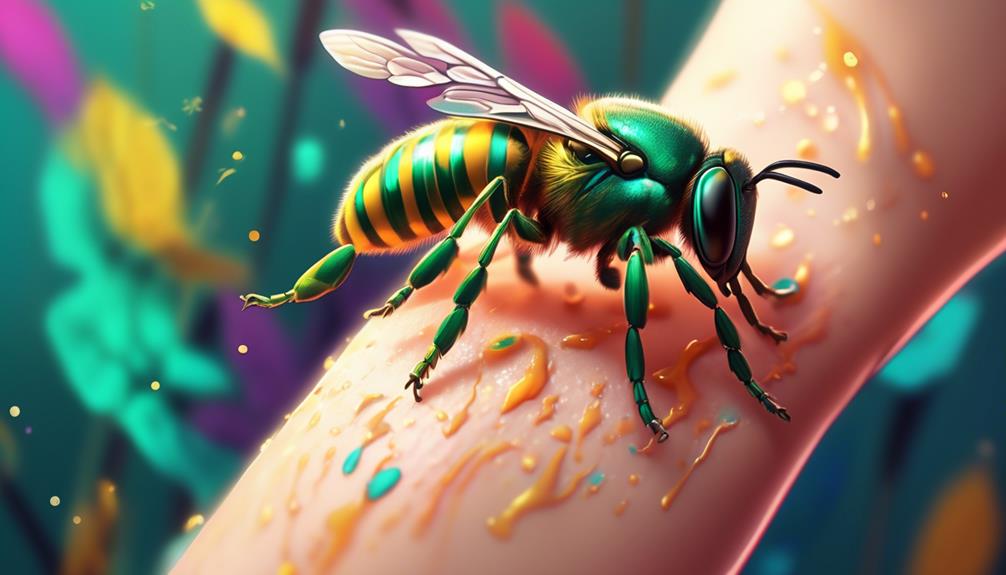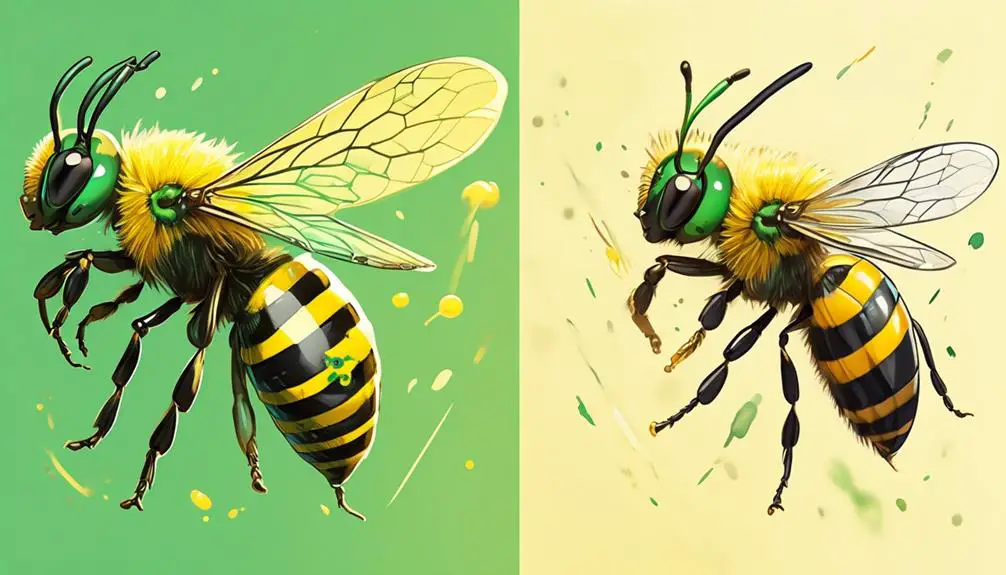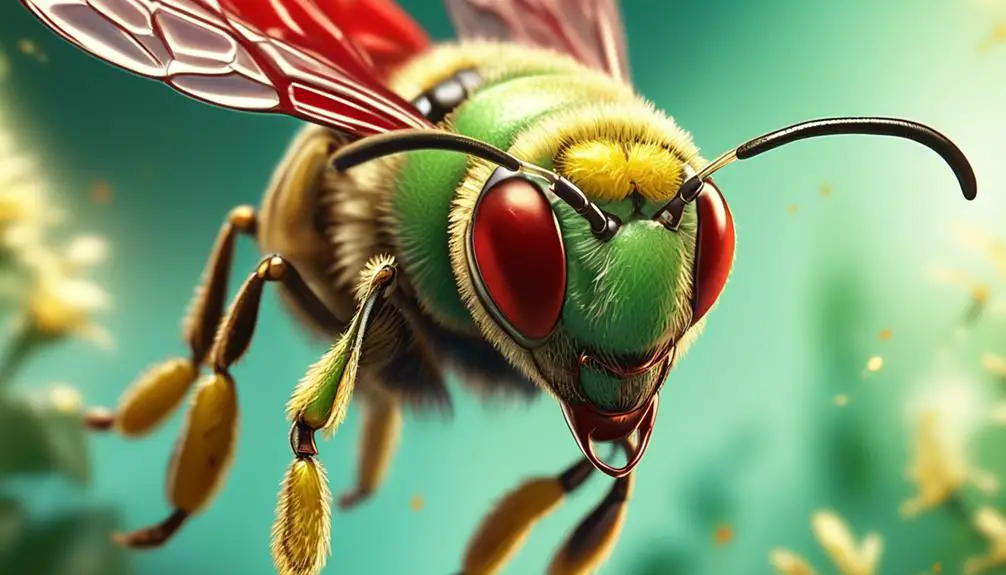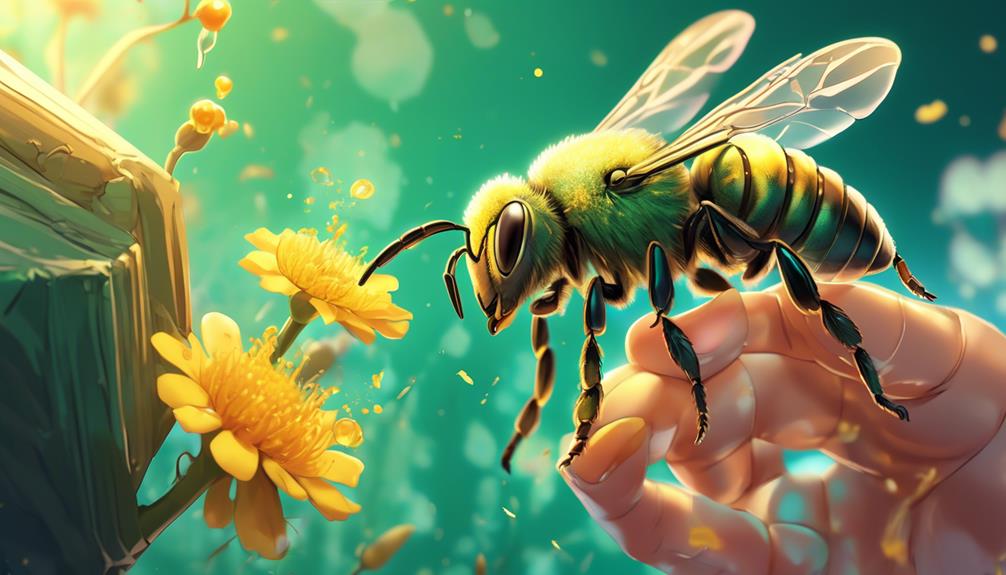Navigate the world of sweat bees and discover if their sting poses a threat or is just a summer inconvenience.

Do Sweat Bees Hurt You
Imagine you're enjoying a summer picnic, and suddenly, a tiny creature lands on your skin, attracted by your perspiration. This is likely a sweat bee, a group of bees known for their attraction to human sweat.
Now, you may wonder, do these bees pose a threat? Could their sting cause harm, or are they just an annoying aspect of warm weather?
Let's explore this further, and you might be surprised by what you discover.
Key Takeaways
- Sweat bees are attracted to human sweat due to the salt it contains, but they are not aggressive and only sting when threatened.
- Sweat bees are significantly smaller than regular bees and prefer to live in sandy or clay soils, while regular bees build their hives in trees or artificial structures.
- The sting of a sweat bee is rated low on the Schmidt Pain Index, similar to a mosquito bite, and is not life-threatening unless the person is allergic to the venom.
- Sweat bees play a significant role in our ecosystem as pollinators and help maintain biodiversity by pollinating a variety of plants.
Understanding Sweat Bees

To fully grasp the nature of sweat bees, you must understand that they're a large group of bees, often small and dark-colored, known for their attraction to human sweat due to the salt it contains. They belong to the Halictidae family, which is one of the most diverse families of bees. Despite their fondness for sweat, they're not aggressive and only sting when threatened.
You'll often find them in gardens or near pools, where they can easily access moisture and salt. They're solitary bees, meaning they don't live in large colonies like honey bees or bumblebees. Instead, each female sweat bee digs her own burrow to lay eggs and provide for her offspring.
Although sweat bees are tiny, they're important pollinators. They're attracted to a wide variety of plants, including fruits, vegetables, and wildflowers. They play a crucial role in maintaining biodiversity and aiding in food production. So, while their name and behavior may sound off-putting, they're a beneficial presence in our environment and pose no significant threat to humans.
Understanding these facts should help alleviate any concerns you may have about sweat bees.
Sweat Bees Vs. Regular Bees

When comparing sweat bees to regular bees, you'll notice several key differences in their size, behavior, and habitat preferences. Sweat bees are significantly smaller, often less than half an inch in size. Regular bees, such as honey bees, are typically larger, with some species reaching up to an inch.
Sweat bees are solitary insects, with each female building and managing her own nest. On the other hand, regular bees are social insects, living in large colonies with a queen, workers, and drones.
Sweat bees prefer to live in sandy or clay soils, often in lawns or gardens. Regular bees usually build their hives in trees or artificial structures.
Aspect | Sweat Bees | Regular Bees |
|---|---|---|
Size | < 0.5 inch | Up to 1 inch |
Behavior | Solitary | Social |
Habitat | Soil | Trees/Structures |
Understanding these differences is crucial when dealing with these insects. While both types of bees are generally harmless unless provoked, their behaviors and habitat preferences can influence how you approach them. For instance, sweat bees are more likely to be found in your garden, while regular bees might be encountered in more wooded areas.
The Sting of Sweat Bees

Although sweat bees are typically non-aggressive, you might feel a slight sting if they're provoked or feel threatened. However, they're not nearly as harmful as their more aggressive cousins, like honey bees or wasps. The sting of a sweat bee is rated a mere 1.0 on the Schmidt Pain Index, a scientific scale that measures the pain of insect stings. This is a mild pain, similar to that of a mosquito bite.
When a sweat bee stings, it injects venom into your skin, causing a small, localized reaction. You'll likely experience redness, swelling, and itching in the affected area. The sting itself might be slightly painful, but it's not life-threatening unless you're allergic to their venom.
In case of a sting, clean the area immediately with soap and water to avoid infection. Apply a cold compress to reduce swelling and take an over-the-counter pain reliever if needed. If you notice symptoms of an allergic reaction, such as difficulty breathing, hives, or dizziness, seek immediate medical attention.
Sweat Bees and Human Interaction

Despite the occasional sting, human interactions with sweat bees are generally benign and these small creatures play a significant role in our ecosystem. They're crucial pollinators, helping to maintain biodiversity by pollinating a variety of plants which you might not be aware of. Contrary to what you might think, sweat bees aren't aggressive unless provoked, and even then, their sting is usually less painful than that of other bees.
The following table provides a snapshot of human interaction with sweat bees:
Interaction | Impact on Human | Impact on Sweat Bee |
|---|---|---|
Sweat Attraction | Mild annoyance, potential for sting | Source of essential minerals |
Gardening | Potential for sting if disturbed | Pollination opportunities |
Agitation | Sting, mild pain | Potential death |
Tips for Preventing Sweat Bee Stings

To prevent sweat bee stings, it's crucial to understand their behavior and take appropriate measures, such as minimizing sweat production and avoiding brightly colored clothing. Sweat bees are attracted to human perspiration, which they use as a source of moisture and salts. Therefore, reducing the amount of sweat you produce, especially during the hot summer months, can make you less of a target. Use antiperspirants, stay hydrated, and wear breathable fabrics to help control sweat.
Avoid wearing bright colors and floral prints, as these can attract sweat bees. They're visually drawn to flowers for their nectar and can mistake your clothing for a food source. Opt instead for light, neutral colors.
Another measure is to keep food and drinks covered when outdoors, as the scent can attract these bees. Similarly, avoid wearing strong perfumes or scented lotions that can act as a lure.
Conclusion
In conclusion, sweat bees can sting, but they're not typically aggressive. You'll likely only feel a pinch, unless you're allergic. They're drawn to human sweat, hence the name.
However, they play a vital role in pollination. To avoid stings, limit sweating outdoors and wear light-colored clothing.
Remember, sweat bees are vital for our ecosystem, so aim to coexist rather than exterminate.


